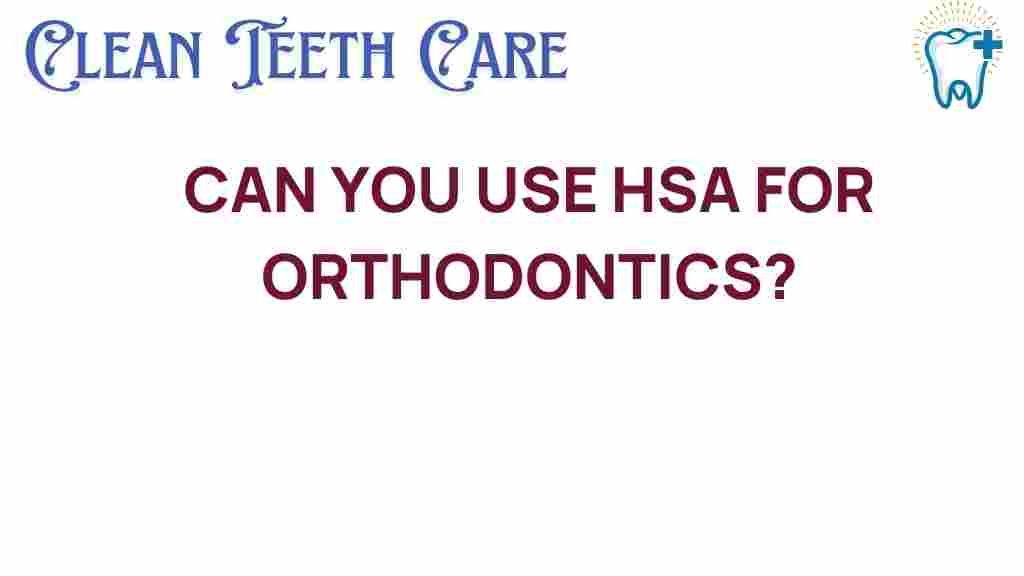Unlocking the Secrets: Can You Use HSA for Orthodontics?
When it comes to managing healthcare costs, many individuals are turning to Health Savings Accounts (HSAs) to save for medical expenses effectively. One area of concern for many families is orthodontic treatments, which can be a significant financial burden. In this article, we will explore whether you can use an HSA for orthodontics, the benefits of using an HSA for dental care, and how this can help you manage your healthcare savings. We will also discuss financing options, insurance considerations, and the costs associated with orthodontic treatments.
Understanding HSA and Its Benefits
A Health Savings Account (HSA) is a tax-advantaged account that allows individuals to save money for qualified medical expenses. To be eligible for an HSA, you must be enrolled in a high-deductible health plan (HDHP). The contributions made to the HSA are tax-deductible, and the funds can grow tax-free, making it an excellent tool for managing healthcare savings.
Benefits of Using HSA for Orthodontics
Using an HSA for orthodontic treatments can provide several advantages:
- Tax Savings: Contributions to your HSA reduce your taxable income, which can lead to significant tax savings.
- Tax-Free Growth: The money in your HSA grows tax-free, allowing you to accumulate savings for future healthcare expenses.
- Tax-Free Withdrawals: Withdrawals made for qualified medical expenses, including orthodontics, are tax-free.
- Flexibility: You can use HSA funds for a variety of dental care treatments, giving you flexibility in managing your healthcare costs.
Can You Use HSA for Orthodontic Treatments?
Yes, you can use your HSA to pay for orthodontic treatments. The Internal Revenue Service (IRS) considers orthodontic care a qualified medical expense, which means you can use HSA funds without incurring taxes or penalties. This includes various treatments such as braces, retainers, and other orthodontic appliances.
Step-by-Step Process to Use HSA for Orthodontics
Using your HSA for orthodontic treatments involves a few straightforward steps:
- Check Your HSA Eligibility: Ensure that you have an HSA and are eligible to use it for medical expenses.
- Consult with Your Orthodontist: Schedule a consultation with your orthodontist to discuss treatment options and costs.
- Request an Itemized Invoice: After your consultation, request a detailed invoice from your orthodontist that outlines the costs associated with your treatment.
- Withdraw Funds from Your HSA: Access your HSA funds either by using a debit card linked to your account or by submitting a reimbursement request.
- Keep Records: Maintain records of your orthodontic expenses and HSA withdrawals for tax purposes.
Financing Orthodontic Treatments
While using an HSA can significantly reduce the out-of-pocket costs associated with orthodontics, some families may still find the total costs overwhelming. Here are some financing options to consider:
- Payment Plans: Many orthodontic practices offer payment plans that allow you to spread the cost of treatment over several months or years.
- Healthcare Credit Cards: Some credit cards are specifically designed for healthcare expenses, offering promotional financing options.
- Insurance Benefits: Check with your dental insurance provider to see if they cover any portion of orthodontic treatments, even if you plan to use your HSA.
Insurance Considerations
It’s essential to understand the relationship between your HSA and dental insurance when considering orthodontic treatments. Here are a few key points:
- Coordination of Benefits: If you have both an HSA and dental insurance, you may be able to maximize your savings by coordinating benefits.
- Pre-Approval: Some insurance plans require pre-approval for orthodontic treatments, which can affect your ability to pay using your HSA.
- Lifetime Maximums: Be aware of any lifetime maximums imposed by your dental insurance for orthodontic treatments.
Costs of Orthodontic Treatments
The costs associated with orthodontic treatments can vary widely based on several factors, including:
- Type of Treatment: Traditional metal braces, ceramic braces, lingual braces, and clear aligners all have different costs.
- Geographic Location: The cost of living in your area can affect orthodontic prices.
- Length of Treatment: The duration of orthodontic treatment will impact the overall cost.
On average, the cost of orthodontic treatment can range anywhere from $3,000 to $7,000, depending on the factors mentioned above. Using your HSA can significantly alleviate these costs.
Troubleshooting Common Issues
While using your HSA for orthodontics is generally straightforward, you may encounter some common issues. Here are some troubleshooting tips:
- Insufficient Funds: Ensure you have enough funds in your HSA to cover the treatment costs before scheduling your appointment.
- Delayed Reimbursement: If you are submitting for reimbursement, keep copies of all invoices and follow up with your HSA administrator if you experience delays.
- Tax Implications: Consult with a tax professional if you are unsure how using your HSA for orthodontics will affect your tax situation.
Conclusion
Using your Health Savings Account (HSA) for orthodontic treatments can be a smart financial decision that helps you save on costs while ensuring you receive the dental care you need. By understanding the benefits of HSAs, the process for using them, and your financing options, you can effectively manage your healthcare savings and reduce the financial burden of orthodontics on your family.
For more information on managing your healthcare expenses, you can visit HealthCare.gov. If you’re considering orthodontic treatments, consult with your orthodontist and determine how you can best utilize your HSA to cover the costs.
Remember, planning ahead is key to maximizing your benefits and achieving a healthy, beautiful smile without breaking the bank!
This article is in the category Treatments and created by CleanTeethCare Team
